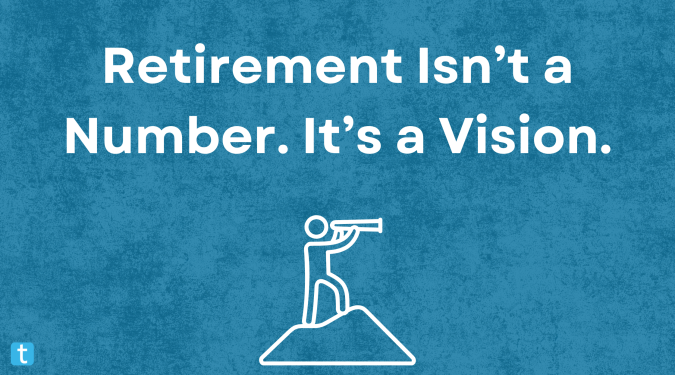Most people start planning for retirement by asking, “How much do I need?”
That’s a fair question. But if you’re like the thoughtful, intentional clients I work with at Together Planning, you probably want something more meaningful than just a number on a page. Retirement isn’t a math problem. It’s a life decision. A number alone won’t keep you motivated, guide your decisions, or help you stay on track.
A better question to start with is:
“What am I retiring to?”
Until you answer that, any retirement plan is just guesswork.
The Problem With Starting at the End
You need a clear picture of what your retirement will actually look like. Not vague ideas, but real, specific details.
– What will your mornings look like?
– What will you do with your time?
– Who will you spend it with?
– Where will you live?
– Will you travel? Volunteer? Start a business? Go fishing?
Whatever your dream is, make it specific. Sketch out a sample week in retirement. If you’re married, have a real conversation about it. Go on a date night, leave the phones at home, and talk about your vision for the future. Create a mock retirement budget. Try living on that budget for a month or two. Is it enough? Does it feel restrictive or freeing?
This kind of clarity matters. When you build your plan around a real-life vision, you avoid two common mistakes:
1. Undershooting. People often guess low because they haven’t thought deeply about what they want. You need to be honest about the lifestyle you’re aiming for so your savings can support it.
2. Overshooting. I’ve worked with people who kept working long after they could have retired, just because they were afraid of not having “enough.” When you understand your true monthly spending needs, it’s much easier to plan with confidence.
A Better Starting Point: Goals First Planning
At Together Planning, we always start with goals. Here’s how you can too.
1. Imagine Your Ideal Week in Retirement – This is simple, but powerful.
Ask yourself:
– Where will you live?
– Who will you spend time with?
– What will fill your mornings, afternoons, and evenings?
You’ll get a much better idea of what your retirement will actually cost once you visualize the lifestyle behind it.
2. Bucket Your Goals
To keep it simple, use two main categories:
– Essential Expenses – These are the non-negotiables like housing, food, healthcare, and transportation. Knowing your minimum required spending can actually be encouraging. You may be closer to retirement than you thought.
– Discretionary Expenses – These are the fun things like travel, hobbies, time with grandkids, giving, or even starting a small business. These are what bring joy and purpose to your retirement years.
With these two categories, you now have two clear targets: one that lets you retire with dignity, and one that lets you retire with purpose.
3. Build the Plan Around Your Life
Now that you’ve defined the life you want and what it will cost, you can reverse-engineer the plan to get there.
– Choose a simple investment strategy that’s easy to stick with. A few low-cost index funds can do the work. Invest passively so you can live actively.
– Let your spending plan reflect your real goals, not just a rule of thumb.
– Decide on a retirement date that’s based on purpose, not just your account balance. This becomes your “Retire on Purpose” date.
Why This Matters
When you build your plan around your values instead of a spreadsheet, everything gets clearer:
– You’ll have a real reason to save
– Investing becomes less stressful
– Retirement becomes something to look forward to
This is the difference between a vague financial plan built by software and a life of meaning you’ve designed for yourself.
Final Thoughts
If you’re in your 50s or 60s, now’s the time to get serious about retirement. But don’t just focus on what you’ve saved. Focus on why you’re saving in the first place.
And if you’re still years away from retirement, this is a great reminder that you don’t have to wait to start living on purpose. Take a look at how you’re spending your time and money now. Are your choices in line with your values?
Before you run another projection or spreadsheet, stop and ask:
“What am I really working toward?”
When your goals are clear, the plan becomes simple.
Together Planning is a registered investment advisor. The information presented is for educational purposes only. It should not be considered specific investment advice, does not take into consideration your specific situation, and does not intend to make an offer or solicitation for the sale or purchase of any securities or investment strategies. Together Planning has a reasonable belief that this marketing does not include any false or material misleading information statements or omissions of facts regarding services, investments, or client experiences. Together Planning has a reasonable belief that the content will not cause an untrue or misleading implication regarding the adviser’s services, investments, or client experiences. Be sure to consult with a qualified financial advisor and/or tax professional before implementing any strategy discussed herein.

